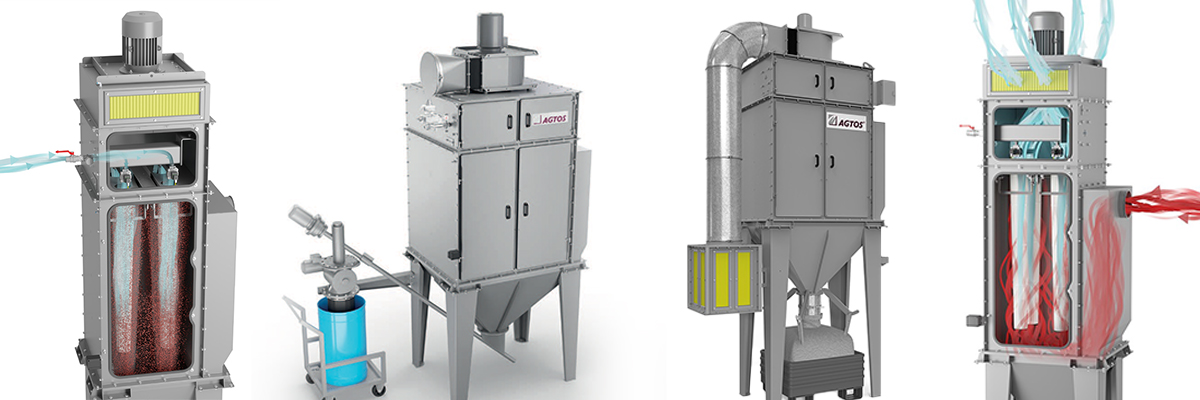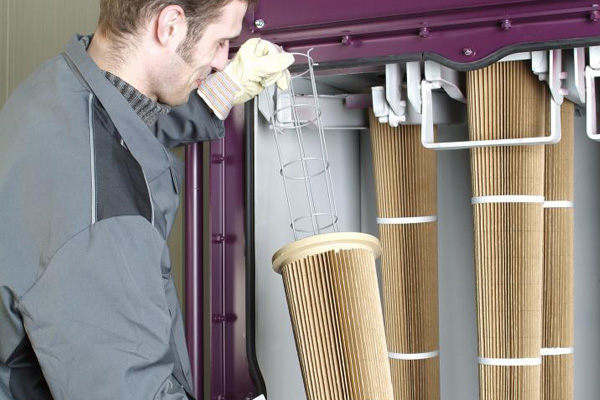AGTOS Cartridge Filter Systems for blast machines

AGTOS has developed a lineup of cartridge filter systems that is setting new standards and making a significant contribution to process safety.
Filtration with process safety
Dust is extracted and flows through the impact separator, where the initial separation of heavy dust particles occurs. After this, dust enters the lower filter chamber and is removed as air flows through the filter cartridges. The clean air then flows upward into the clean gas chamber. The filter cartridges are cleaned in programmable intervals using pulses of compressed air. The dust particles are fed to a hopper located beneath the filter, where they are collected in a dust collection container made of metal or paper. Clean air is released to the outside environment through openings in the side of the upper filter housing. In the event that a filter cartridge is destroyed, additional filter inserts collect the dust to the greatest possible extent. Through the lateral opening in the upper filter housing, the cleaned air will be lead off outwards. If a filter cartridge is damaged, additional filter inserts will catch the dust as far as possible till the damage is eliminated.
Easy maintenance
Newly developed slide-in inserts simplify the exchange and replacement of cartridges. The cartridges are pulled from the filter unit and can then be replaced outside the filter in a clean environment. The cartridges are still precisely positioned when reinserted and always install with the proper contact pressure.

AGTOS has developed a lineup of cartridge filter systems that is setting new standards and making a significant contribution to process safety.
Special filter cartridges
AGTOS filter cartridges have a conical shape that permits the compressed air impulse to more directly impact the inside of the side walls and the attached coating of dust. In comparison to other cartridge types, the overall area of the filter surface is smaller. Despite this, the special structure of the paper or polyester fabric makes it possible to draw more air per m2 through the cartridge. In addition, the use of a rougher fold provides for better dust adhesion and cleaning because the dust is dislodged more easily by the compressed air impulse.
Environmentally friendly and cost-saving
In comparison to the smooth sidewalls of conventional filter cartridges, the conical shape of the filter cartridges alone is enough to achieve a better utilization of the compressed air pulses. In addition, the inner volume of the cartridges is less that that of cylindrical cartridges, a feature that increases the effectiveness of the compressed air pulses. The disposal process illustrates yet another advantage: the loading-bearing metal body is reusable. Only the paper or polyester wrapping requires disposal. Depending on the type of dust collected, this wrapping can usually be burned or disposed of as common industrial waste. This eliminates additional disposal costs.
Application requirements determine the material
Standard applications use so-called paper filter cartridges that are manufactured in an environmentally friendly manner from unbleached cellulose. These cartridges are characterized by good filtration efficiency when dealing with fine dust particles and can be easily cleaned. Filter cartridges equipped with polyester fabric are used to collect ultra-fine dust particles and in applications where air inflow velocities are high. These cartridges also exhibit high stability and excellent wet strength.
Advantages of the AGTOS filter units
- A quick release system makes it possible to exchange cartridges in a very short period of time. The system ensures that cartridges are always installed with the correct contact pressure in an absolutely centralized position.
- The conical shape of the filter cartridges ensures the optimized routing of air. The intensity of the compressed air blast can be lowered and the filter material is protected.
- During cleaning, dust dislodges more easily because of the filter cartridge’s wide-angle fold.
- Environmentally friendly disposal through material separation and a low amount of waste.
- Depending on the application, cartridge filters are available in paper or polyester fabric.
- The filter unit can be equipped with a variety of dust collection containers: paper sacks, metal containers, big bags or dustbins.
- An impact separator installed in the filter housing is used to pre-separate dust. It prevents coarse dust particles from damaging the filter cartridges.
- By using an integrated secondary filter, residual dust levels < 1 mg are achieved. This makes it possible to re-circulate exhaust air into the workshop hall.
- Maintenance-friendly construction with large maintenance openings.
- Inexpensive spare parts.



